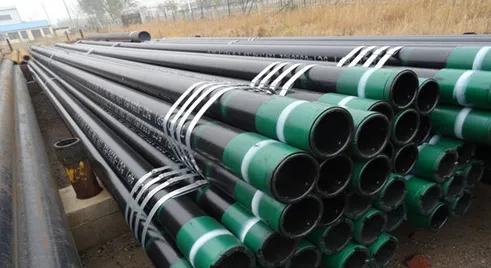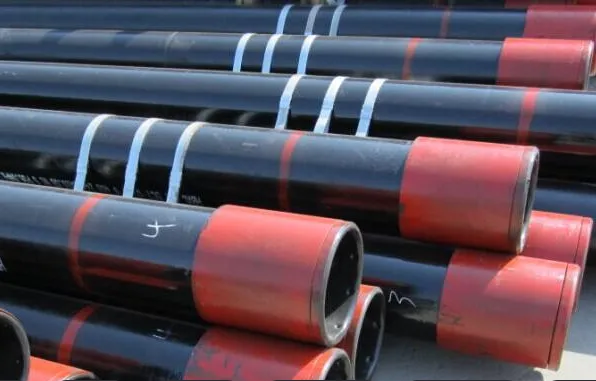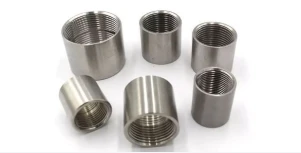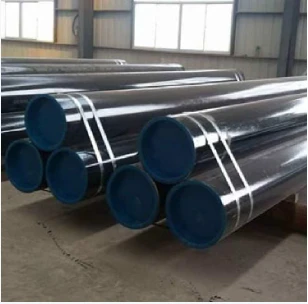Mechanical property
High strength: The oil pipeline needs to withstand the pressure of internal oil products and the pressure generated by external soil, geology and other factors. For example, the long distance crude oil transmission pipeline, the working pressure may be as high as tens of mpa, which requires the pipeline material to have a high yield strength and tensile strength to prevent the pipeline from cracking or deformation. Common high-strength steel pipes can meet this requirement, such as the yield strength of X80 steel can reach more than 550MPa.
Good toughness: the oil pipeline may face complex conditions such as low temperature and impact, and good toughness can make the pipeline less prone to brittle fracture under these circumstances. For example, in cold areas, pipeline materials need to maintain a certain toughness at low temperatures to cope with possible frost heaving and other situations. Generally by adding specific elements to the material, such as nickel, to improve its low-temperature toughness.
Fatigue resistance: Because the flow of oil in the pipeline will produce certain pressure fluctuations, and the pipeline may be subjected to various alternating loads during operation, the pipeline needs to have good fatigue resistance to ensure that it will not fail due to the expansion of fatigue cracks during long-term use.
Corrosion resistance: the oil may contain corrosive substances such as hydrogen sulfide and carbon dioxide, and the outside of the pipeline will also be corroded by environmental media such as soil and water. Therefore, the oil pipeline needs to have good corrosion resistance to extend the service life of the pipeline. For example, the use of corrosion-resistant alloy materials or pipeline anticorrosive coating treatment and other measures.
material
Carbon steel
Features: With high strength and good toughness, relatively low price, good process performance, easy processing and welding.
Application scenario: Widely used in various pressure levels and transportation distances of oil pipelines, especially in the environment where corrosion resistance requirements are not particularly high, such as the transportation of crude oil without a large number of corrosive media.
Alloy steel
Features: On the basis of carbon steel, chromium, molybdenum, nickel and other alloying elements are added to improve the strength, toughness, corrosion resistance and high temperature resistance of steel.
Application scenario: It is suitable for transporting highly corrosive crude oil or refined oil with high sulfur content and high carbon dioxide content, as well as oil pipelines under harsh working conditions such as high temperature and high pressure, such as deep-sea oil pipelines.
Stainless steel
Features: It has excellent corrosion resistance, oxidation resistance and good mechanical properties, and can maintain stable performance in a variety of harsh environments.
Application scenario: It is often used in special oil transmission occasions with high corrosion resistance requirements, such as pipelines transporting petrochemical products containing high concentrations of corrosive substances such as acids and alkalis, or in some food-grade oil transportation with high health requirements.
Composite material
Features: Composed of two or more materials with different properties through a certain process combination, such as fiber reinforced composite materials, etc., with light weight, high strength, corrosion resistance, good insulation properties and other advantages.
Application scenario: In some special environments, such as crossing rivers, lakes and other occasions that need to reduce the weight of the pipeline, and in some oil pipelines that have requirements for electrical insulation performance, it has certain application advantages.
-
Cangzhou Yulong Steel Co., Ltd.
-
ਫ਼ੋਨ:
+86 13303177267 -
ਈ - ਮੇਲ:
admin@ylsteelfittings.com
- ਅੰਗਰੇਜ਼ੀ
- ਅਰਬੀ
- ਇਤਾਲਵੀ
- ਸਪੇਨੀ
- ਪੁਰਤਗਾਲੀ
- ਜਰਮਨ
- ਕਜ਼ਾਖ
- ਫਾਰਸੀ
- ਯੂਨਾਨੀ
- ਫ੍ਰੈਂਚ
- ਰੂਸੀ
- ਪੋਲਿਸ਼
- ਥਾਈ
- ਇੰਡੋਨੇਸ਼ੀਆਈ
- ਵੀਅਤਨਾਮੀ
- ਜ਼ੁਲੂ
- ਕੋਰੀਅਨ
- ਉਜ਼ਬੇਕ
- ਨਹੀਂ
- ਸਰਬੀਆਈ
- ਮਾਲੇ
- ਯੂਕਰੇਨੀ
- ਗੁਜਰਾਤੀ
- ਹੈਤੀਆਈ ਕ੍ਰੀਓਲ
- ਹਾਉਸਾ
- ਹਵਾਈਅਨ
- ਇਬਰਾਨੀ
- ਮੀਆਓ
- ਹੰਗੇਰੀਅਨ
- ਆਈਸਲੈਂਡਿਕ
- igbo
- ਆਇਰਿਸ਼
- ਜਾਪਾਨੀ
- ਜਾਵਨੀਜ਼
- ਕੰਨੜ
- ਖਮੇਰ
- ਰਵਾਂਡਾ
- ਅਫਰੀਕਨ
- ਅਲਬਾਨੀਅਨ
- ਅਮਹਾਰਿਕ
- ਅਰਮੀਨੀਆਈ
- ਅਜ਼ਰਬਾਈਜਾਨੀ
- ਬਾਸਕ
- ਬੇਲਾਰੂਸੀ
- ਬੰਗਾਲੀ
- ਬੋਸਨੀਆਈ
- ਬਲਗੇਰੀਅਨ
- ਕੈਟਲਨ
- ਸੇਬੁਆਨੋ
- ਚੀਨ
- ਚੀਨ (ਤਾਈਵਾਨ)
- ਕੋਰਸਿਕਨ
- ਕਰੋਸ਼ੀਅਨ
- ਚੈੱਕ
- ਡੈਨਿਸ਼
- ਐਸਪੇਰਾਂਟੋ
- ਐਸਟੋਨੀਅਨ
- ਫਿਨਿਸ਼
- ਫ੍ਰੀਜ਼ੀਅਨ
- ਗੈਲੀਸ਼ੀਅਨ
- ਜਾਰਜੀਅਨ
- ਕੁਰਦਿਸ਼
- ਕਿਰਗਿਜ਼
- ਟੀ.ਬੀ
- ਲਾਤੀਨੀ
- ਲਾਤਵੀਅਨ
- ਲਿਥੁਆਨੀਅਨ
- ਲਕਸਮਬਰਗਿਸ਼
- ਮੈਸੇਡੋਨੀਅਨ
- ਮਾਲਗਾਸ਼ੀ
- ਮਲਿਆਲਮ
- ਮਾਲਟੀਜ਼
- ਮਾਓਰੀ
- ਮਰਾਠੀ
- ਮੰਗੋਲੀਆਈ
- ਮਿਆਂਮਾਰ
- ਨੇਪਾਲੀ
- ਨਾਰਵੇਜਿਅਨ
- ਨਾਰਵੇਜਿਅਨ
- ਆਕਸੀਟਨ
- ਪਸ਼ਤੋ
- ਡੱਚ
- ਪੰਜਾਬੀ
- ਰੋਮਾਨੀਅਨ
- ਸਮੋਆਨ
- ਸਕਾਟਿਸ਼ ਗੈਲਿਕ
- ਅੰਗਰੇਜ਼ੀ
- ਸ਼ੋਨਾ
- ਸਿੰਧੀ
- ਸਿੰਹਾਲਾ
- ਸਲੋਵਾਕ
- ਸਲੋਵੇਨੀਆਈ
- ਸੋਮਾਲੀ
- ਸੁੰਡਨੀਜ਼
- ਸਵਾਹਿਲੀ
- ਸਵੀਡਿਸ਼
- ਤਾਗਾਲੋਗ
- ਤਾਜਿਕ
- ਤਾਮਿਲ
- ਤਾਤਾਰ
- ਤੇਲਗੂ
- ਤੁਰਕੀ
- ਤੁਰਕਮੇਨ
- ਉਰਦੂ
- ਉਈਗਰ
- ਵੈਲਸ਼
- ਮਦਦ ਕਰੋ
- ਯਿੱਦੀ
- ਯੋਰੂਬਾ

ਆਪਣਾ ਸੁਨੇਹਾ ਇੱਥੇ ਲਿਖੋ ਅਤੇ ਸਾਨੂੰ ਭੇਜੋ
Related News
-
Jul . 16, 2025Wrench-Tight, Ready-to-Go: How ISO Thread Couplings Become the Time-Saving Hero in Pipe MaintenanceIn the fast-paced world of industrial and residential pipe systems, downtime equals loss—whether it’s a leaking faucet in a home or a critical pipeline shutdown in a factory.
-
Jul . 16, 2025The Versatility of ASTM A53 Gr.B Carbon Steel Pipe: YULONG Steel’s Solution for Low-Pressure Fluid TransportationWhen it comes to low-pressure fluid conveyance systems, ASTM A53 Gr.B carbon steel pipe emerges as the quintessential “all-rounder” — a testament to its superior welding performance, machining adaptability, and robust mechanical strength.
















